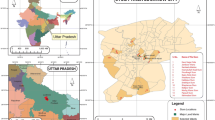Abstract
This study is based on a visual inspection and a questionnaire survey about sanitation in central Nepal. A total of 201 people from different groups were asked about their knowledge about eco-toilets, the fertilizer value of human urine and wood ash. Farmers were the least educated and least aware of most of the topics asked. Although the majority of educated people were aware about urine fertilizer, 68% of them were not interested in its use in their home, and 39% of them said that it might be not accepted. The visual inspection revealed that environmental hygiene depends on education. It is concluded that farmers need to receive practical demonstrations about the use of eco-toilets and wood ash to appreciate the direct benefits. It can be assumed that since urine fertilizer is a bonus obtained from eco-toilets, this could encourage even poor people to construct these kinds of facilities.




Similar content being viewed by others
References
Asaolu, S. O., & Ofoezie, I. E. (2003). The role of health education and sanitation in the control of helminth infections. Acta Tropica, 86(2–3), 283–294.
Bhat, M. G., English, B. C., Turhollow, A. F., & Nyangito, H. (1994). Energy in synthetic agricultural inputs: Revisited. Oak Ridge National Laboratory report ORNL/Sub/90-99732/2. Oak Ridge, TN: Oak Ridge National Laboratory.
Erich, M. S. (1991). Agronomic effectiveness of wood ash as a source of phosphorus and potassium. Journal of Environmental Qualily, 20, 576–581.
Escher, B. I., Pronk, W., Suter, M. J.-F., & Maurer, M. (2006). Monitoring the removal efficiency of pharmaceuticals and hormones in different treatment processes of source-separated urine with bioassays. Environmental Science Technology, 40(16), 5095–5101.
Fehr, M., Sousa, K. A., Pereira, A. F. N., & Pelizer, L. C. (2004). Proposal of indicators to assess urban sustainability in Brazil. Environment, Development and Sustainability, 6, 355–366.
Heinonen-Tanski, H., Sjöblom, A., Fabritius, H., & Karinen, P. (2007). Pure human urine is a good fertilizer for cucumbers. Bioresource Technolology, 98, 214–217.
Heinonen-Tanski, H., Snel, M., Wijk-Sijbesma, C. V., Quazi, A. R., Mathew, K., Werellagama, I., et al. (2006). Assessing of environmental quality in six areas in India, Sri Lanka and Bangladesh. Environment, Development and Sustainability, 9, 355–368.
Höglund, C., Stenström, T. A., & Ashbolt, N. (2002). Microbial risk assessment of source-separated urine used in agriculture. Waste Management & Research, 20(2), 150–161.
Kiff, E., Turton, C., Tuladhar, J. K., & Baker, R. (1995). A review of literature relating to soil fertility in the hills of Nepal. Chatham Maritime, UK: NRI/LARC Project.
Larsen, T. A., & Gujer, W. (1997). The concept of sustainable urban water management. Water Science Technology, 35(9), 3–10.
Lienert, J., Haller, M., Berner, A., Stauffacher, M., & Larsen, T. A. (2003). How farmers in Switzerland perceive fertilizers from recycled anthropogenic nutrients (urine). Water Science and Technology, 48(1), 47–56.
Lienert, J., & Larsen, T. A. (2006). Considering user attitude in early development of environmentally friendly technology: A case study of NoMix toilets. Environmental Science and Technology, 40(16), 4838–4844.
Manandhar, D. R., Shiwakoti, N., & Kafley, S. (2004). Piloting ecological sanitation toilets in peri-urban community of Nepal. In 30th WEDC International Conference, Vientiane, Lao PDR. http://wedc.lboro.ac.uk/publications/pdfs/30/Manandhar.pdf.
Medilanski, E., Chuan, L., Mosler, H.-J., Schertenleib, R., & Larsen, T. A. (2006). Wastewater management in Kunming, China: A stakeholder perspective on measures at the source. Environment and Urbanization, 18(2), 353–368.
Otterpohl, R. (2002). Options for alternative types of sewerage and systems directed to improvement of the overall performance. Water Science Technology, 45(3), 149–158.
Pilbeam, C. J., Mathema, S. B., Gregory, P. J., & Shakya, P. B. (2005). Soil fertility management in the mid-hills of Nepal: Practices and perceptions. Agriculture and Human Values, 22, 243–258.
Pilbeam, C. J., Tripathi, B. P., Sherchan, D. P., Gregory, P. J., & Gaunt, J. (2000). Nitrogen balances for households in the mid-hills of Nepal. Agriculture Ecosystem and Environment, 79, 61–72.
Pradhan, S. K., Nerg, A.-M., Sjöblom, A., Holopainen, J. K., & Heinonen-Tanski, H. (2007). Use of human urine fertilizer in cultivation of cabbage (Brassica oleracea)—impacts on chemical, microbial and flavor quality. Journal of Agriculture and Food Chemistry, 55, 8657–8662.
Pradhan, R., & Shrestha, A. (2005). Ethnic and caste diversity: Implications for development. Working paper serial no. 4, Nepal Resident Mission, ADB. http://www.adb.org/Documents/Papers/NRM/wp4.pdf.
Regmi, M. R. (2005). A sustainable approach towards rural development: Dry toilets in Nepal. Water Science and Technology, 52(12), 19–24.
Sherchan, D. P., & Karki, K. B. (2006). Plant nutrient management for improving crop productivity in Nepal. Kathmandu, Nepal: Soil Science Division, Nepal Agricultural Research Council (NARC). Online available in FAO corporate document repository. http://www.fao.org/docrep/010/ag120e/AG120E10.htm.
Subedi, K. D., Subedi, M., & Sthapit, B. R. (1996). Research highlights on composting, compost utilization and in situ manuring in the western hills of Nepal. In K. D. Joshi, A. K. Vaidya, B. P. Tripathi & B. Pound (Eds.), Formulating a strategy for soil fertility research in the Hills of Nepal (pp. 70–78). Pokhara, Nepal: Lumle Agricultural Research Centre and Chatham Maritime; UK: Natural Resources Institute.
UNFPA. (2007). www.unfpa.org/swp/2007/presskit/country_data/nepal.xls.
United Nation (UN). (2007). http://esa.un.org/iys/ (updated on 2007).
WHO. (2007). http://www.searo.who.int/EN/Section313/Section1523_6864.htm (updated on 06 August 2007).
Acknowledgments
We would like to thank the staffs of the schools, colleges and NGOs from the study area in Nepal who arranged the meeting with students, staffs and the local farmers for presentation and helping conducting the questionnaire survey. We would like to thank Finnish Ministry of Education funded graduate school (SYTYKE) for financial support for travel and also Dr Ewen MacDonald for language correction.
Author information
Authors and Affiliations
Corresponding author
Additional information
Readers should send their comments on this paper to BhaskarNath@aol.com within 3 months of publication of this issue.
Rights and permissions
About this article
Cite this article
Pradhan, S.K., Heinonen-Tanski, H. Knowledge and awareness of eco-sanitation in central Nepal: a questionnaire survey. Environ Dev Sustain 12, 713–726 (2010). https://doi.org/10.1007/s10668-009-9220-5
Received:
Accepted:
Published:
Issue Date:
DOI: https://doi.org/10.1007/s10668-009-9220-5




